Physical, Mechanical and Durability Properties of Ecofriendly Ternary Concrete Made with Sugar Cane Bagasse Ash and Silica Fume
Abstract
1. Introduction
2. Materials and Methods
2.1. Materials
2.2. Proportioning of the Mixtures MC and ETC
2.3. Physical Properties of Concrete Mixtures
2.4. Mechanical and Durability Properties of Eco-Friendly Ternary Concrete Mixtures
2.4.1. Compressive Strength
2.4.2. Rebound Number
2.4.3. Electrical Resistivity
3. Results and Discussion
3.1. Slump
3.2. Temperature
3.3. Unit Weight
3.4. Mechanical and Durability Properties
3.4.1. Compressive Strength
3.4.2. Rebound Number
3.4.3. Electrical Resistivity of Concrete Mixtures
4. Conclusions
Author Contributions
Funding
Institutional Review Board Statement
Informed Consent Statement
Data Availability Statement
Acknowledgments
Conflicts of Interest
References
- Raczkiewicz, W.; Wójcicki, A. Temperature impact on the assessment of reinforcement corrosion risk in concrete by galvanostatic pulse method. Appl. Sci. 2020, 10, 1089. [Google Scholar] [CrossRef]
- Baltazar, M.A.; Márquez, S.; Landa, L.; Croche, R.; López, O. Effect of the type of curing on the corrosion behavior of concrete exposed to urban and marine environment. Eur. J. Eng. Technol. Res. 2020, 5, 91–95. [Google Scholar] [CrossRef]
- Cramer, S.D.; Covino, B.S., Jr.; Bullard, S.J.; Holcomb, G.R.; Russell, J.H.; Nelson, F.J.; Laylor, H.M.; Soltesz, S.M. Corrosion prevention and remediation strategies for reinforced concrete coastal bridge. Cem. Concr. Compos. 2002, 24, 101–117. [Google Scholar] [CrossRef]
- Troconis de Rincón, O.; Montenegro, J.C.; Vera, R.; Carvajal, A.M.; De Gutiérrez, R.M.; Del Vasto, S.; Saborio, E.; Torres-Acosta, A.; Pérez-Quiroz, J.; Martínez-Madrid, M.; et al. Reinforced Concrete Durability in Marine Environments DURACON Project: Long-Term Exposure. Corrosion 2016, 72, 824–833. [Google Scholar] [CrossRef]
- Liang, M.T.; Lan, J.-J. Reliability analysis for the existing reinforced concrete pile corrosion of bridge substructure. Cem. Concr. Res. 2005, 35, 540–550. [Google Scholar] [CrossRef]
- Baltazar, M.A.; Maldonado, M.; Tello, M.; Santiago, G.; Coca, F.; Cedano, A.; Barrios, C.P.; Nuñez, R.; Zambrano, P.; Gaona, C.; et al. Efficiency of galvanized steel embedded in concrete previously contaminated with 2, 3 and 4% of NaCl. Int. J. Electrochem. Sci. 2012, 7, 2997–3007. [Google Scholar]
- Landa, L.; Croche, R.; Santiago, G.; Moreno, V.; Cuevas, J.; Méndez, C.; Jara, M.; Baltazar, M.A. Evaluation of the Influence of the Level of Corrosion of the Reinforcing Steel in the Moment-Curvature Diagrams of Rectangular Concrete Columns. Eur. J. Eng. Technol. Res. 2021, 6, 74–80. [Google Scholar] [CrossRef]
- Santiago, G.; Baltazar, M.A.; Galván, R.; López, L.; Zapata, F.; Zambrano, P.; Gaona, C.; Almeraya, F. Electrochemical evaluation of reinforcement concrete exposed to soil Type SP contaminated with sulphates. Int. J. Electrochem. Sci. 2016, 11, 4850–4864. [Google Scholar] [CrossRef]
- Saricimen, H.; Mohammad, M.; Quddus, A.; Shameem, M.; Barry, M.S. Effectiveness of concrete inhibitors in retarding rebar corrosion. Cem. Concr. Compos. 2002, 24, 89–100. [Google Scholar] [CrossRef]
- Baltazar, M.; Almeraya, F.; Nieves, D.; Borunda, A.; Maldonado, E.; Ortiz, A. Corrosión del acero inoxidable 304 como refuerzo en concreto expuesto a cloruros y sulfatos. Sci. Tech. 2007, 13, 353–357. [Google Scholar]
- Shaheen, F.; Pradhan, B. Influence of sulfate ion and associated cation type on steel reinforcement corrosion in concrete powder aqueous solution in the presence of chloride ions. Cem. Concr. Res. 2017, 91, 73–86. [Google Scholar] [CrossRef]
- Baltazar, M.A.; Santiago, G.; Gaona, C.; Maldonado, M.; Barrios, C.P.; Nunez, R.; Perez, T.; Zambrano, P.; Almeraya, F. Evaluation of the corrosion at early age in reinforced concrete exposed to sulfates. Int. J. Electrochem. Sci. 2012, 7, 588–600. [Google Scholar]
- Roventi, G.; Bellezze, T.; Giuliani, G.; Conti, C. Corrosion resistance of galvanized steel reinforcements in carbonated concrete: Effect of wet–dry cycles in tap water and in chloride solution on the passivating layer. Cem. Concr. Res. 2014, 65, 76–84. [Google Scholar] [CrossRef]
- Baltazar, M.A.; Mendoza, J.M.; Croche, R.; Gaona, C.; Hernández, C.; López, L.; Olguín, F.; Almeraya, F. Corrosion behavior of galvanized steel embedded in concrete exposed to soil type MH contaminated with chlorides. Front. Mater. 2019, 6, 257. [Google Scholar] [CrossRef]
- Mahasenan, N.; Smith, S.; Humphreys, K. The cement industry and global climate change current and potential future cement Industry CO2 emissions. In Greenhouse Gas Control Technologies—6th International Conference, Kyoto, Japan, 1–4 October 2002; Elsevier: Amsterdam, The Netherlands, 2003; pp. 995–1000. [Google Scholar]
- Worrell, E.; Price, L.; Martin, N.; Hendriks, C.; Ozawa, L.M. Carbon dioxide emissions from the global cement industry. Annu. Rev. Energy Environ. 2001, 26, 303–329. [Google Scholar] [CrossRef]
- Monteiro, P.; Miller, S.; Horvath, A. Towards sustainable concrete. Nat. Mater. 2017, 16, 698–699. [Google Scholar] [CrossRef] [PubMed]
- Mehdi, M.; Hamidreza, S.; Farhangi, V.; Karakouzian, M. Predicting the Effect of Fly Ash on Concrete’s Mechanical Properties by ANN. Sustainability 2021, 13, 1469. [Google Scholar]
- Shinga, D.; Sil, A. Effect of Partial Replacement of Cement by Silica Fume on Hardened Concrete. Int. J. Emerg. Technol. Adv. Eng. 2012, 2, 472–475. [Google Scholar]
- Zhang, X.; An Yan, K.W. Carbonation property of hardened binder pastes containing super-pulverized blast-furnace slag. Cem. Concr. Compos. 2004, 26, 371–374. [Google Scholar] [CrossRef]
- Safiuddin, M.; West, J.S.; Soudki, K.A. Hardened properties of self-consolidating high performance concrete including rice husk ash. Cem. Concr. Compos. 2010, 32, 708–717. [Google Scholar] [CrossRef]
- Baltazar, M.A.; Ariza, H.; Landa, L.; Croche, R. Electrochemical evaluation of AISI 304 SS and galvanized steel in ternary ecological concrete based on sugar cane bagasse ash and silica fume (SCBA-SF) exposed to Na2SO4. Eur. J. Eng. Res. Sci. 2020, 5, 353–357. [Google Scholar] [CrossRef]
- Jagadesha, P.; Ramachandramurthy, A.; Murugesan, R. Evaluation of mechanical properties of Sugar Cane Bagasse Ash concrete. Constr. Build. Mater. 2018, 176, 608–617. [Google Scholar] [CrossRef]
- Baltazar, M.A.; Landa, A.; Landa, L.; Ariza, H.; Gallego, P.; Ramírez, A.; Croche, R.; Márquez, S. Corrosion of AISI 316 stainless steel embedded in sustainable concrete made with sugar cane bagasse ash (SCBA) exposed to marine environment. Eur. J. Eng. Res. Sci. 2020, 5, 127–131. [Google Scholar] [CrossRef][Green Version]
- Luo, M.; Jing, K.; Bai, J.; Ding, Z.; Yang, D.; Huang, H.; Go, Y. Effects of Curing Conditions and Supplementary Cementitious Materials on Autogenous Self-Healing of Early Age Cracks in Cement Mortar. Crystals 2021, 11, 752. [Google Scholar] [CrossRef]
- Anandan, S.; Manoharan, S.V. Strength Properties of Processed Fly Ash Concrete. J. Eng. Technol. Sci. 2015, 47, 320–334. [Google Scholar] [CrossRef]
- Baltazar, M.A.; Bastidas, D.M.; Santiago, G.; Mendoza, J.M.; Gaona, C.; Bastidas, J.M.; Almeraya, F. Effect of silica fume and fly ash admixtures on the corrosion behavior of AISI 304 embedded in concrete exposed in 3.5% NaCl solution. Materials 2019, 12, 4007. [Google Scholar] [CrossRef]
- Atis, C.D.; Ozcan, F.; Kılıc, A.; Karahan, O.; Bilim, C.; Severcan, M.H. Influence of dry and wet curing conditions on compressive strength of silica fume concrete. Build. Environ. 2005, 40, 1678–1683. [Google Scholar] [CrossRef]
- Bhanja, S.; Sengupta, B. Influence of silica fume on the tensile strength of concrete. Cem. Concr. Res. 2005, 35, 743–747. [Google Scholar] [CrossRef]
- Ozcan, F.; Atis, C.D.; Karahan, O.; Uncuoglu, E.; Tanyildizi, H. Comparison of artificial neural network and fuzzy logic models for prediction of long-term compressive strength of silica fume concrete. Adv. Eng. Softw. 2009, 40, 856–863. [Google Scholar] [CrossRef]
- Landa-Ruiz, L.; Baltazar-Zamora, M.A.; Bosch, J.; Ress, J.; Santiago-Hurtado, G.; Moreno-Landeros, V.M.; Márquez-Montero, S.; Méndez, C.; Borunda, A.; Juárez-Alvarado, C.A.; et al. Electrochemical Corrosion of Galvanized Steel in Binary Sustainable Concrete Made with Sugar Cane Bagasse Ash (SCBA) and Silica Fume (SF) Exposed to Sulfates. Appl. Sci. 2021, 11, 2133. [Google Scholar] [CrossRef]
- Srinivasan, R. Experimental Study on Bagasse Ash in Concrete. Int. J. Serv. Learn. Eng. 2010, 5, 60–66. [Google Scholar] [CrossRef]
- Landa-Sánchez, A.; Bosch, J.; Baltazar-Zamora, M.A.; Croche, R.; Landa-Ruiz, L.; Santiago-Hurtado, G.; Moreno-Landeros, V.M.; Olguín-Coca, J.; López-Léon, L.; Bastidas, J.M.; et al. Corrosion behavior of steel-reinforced green concrete containing recycled coarse aggregate additions in sulfate media. Materials 2020, 13, 4345. [Google Scholar] [CrossRef] [PubMed]
- Kawade, U.R.; Rathi, V.R.; Girge, V.D. Effect of use of Bagasse Ash on Strength of Concrete. Int. J. Innov. Res. Sci. Eng. Technol. 2013, 2, 2997–3000. [Google Scholar]
- Castaldelli, V.; Akasaki, J.; Melges, J.; Tashima, M.; Soriano, L.; Borrachero, M.; Monzó, J.; Payá, J. Use of Slag/Sugar Cane Bagasse Ash (SCBA) Blends in the Production of Alkali-Activated Materials. Materials 2013, 6, 3108–3127. [Google Scholar] [CrossRef] [PubMed]
- Ariza-Figueroa, H.A.; Bosch, J.; Baltazar-Zamora, M.A.; Croche, R.; Santiago-Hurtado, G.; Landa-Ruiz, L.; Mendoza-Rangel, J.M.; Bastidas, J.M.; Almeraya-Calderón, F.A.; Bastidas, D.M. Corrosion behavior of AISI 304 stainless steel reinforcements in SCBA-SF ternary ecological concrete exposed to MgSO4. Materials 2020, 13, 2412. [Google Scholar] [CrossRef]
- Ganesan, K.; Rajagopal, K.; Thangavel, K. Evaluation of bagasse ash as corrosion resisting admixture for carbon steel in concrete. Anti-Corros. Methods Mater. 2007, 54, 230–236. [Google Scholar] [CrossRef]
- Landa-Gómez, A.E.; Croche, R.; Márquez-Montero, S.; Villegas Apaez, R.; Ariza-Figueroa, H.A.; Estupiñan López, F.; Gaona Tiburcio, G.; Almeraya Calderón, F.; Baltazar-Zamora, M.A. Corrosion behavior 304 and 316 stainless steel as reinforcement in sustainable concrete based on sugar cane bagasse ash exposed to Na2SO4. ECS Trans. 2018, 84, 179–188. [Google Scholar] [CrossRef]
- Ramakrishnan, K.; Ganesh, V.; Vignesh, G.; Vignesh, M.; Shriram, V.; Suryaprakash, R. Mechanical and durability properties of concrete with partial replacement of fine aggregate by sugarcane bagasse ash (SCBA). Mater. Today Proc. 2021, 42, 1070–1076. [Google Scholar] [CrossRef]
- Ojeda, O.; Mendoza, J.M.; Baltazar, M.A. Influence of sugar cane bagasse ash inclusion on compacting, CBR and unconfined compressive strength of a subgrade granular material. Rev. Alconpat 2018, 8, 194–208. [Google Scholar]
- Landa, L.; Márquez, S.; Santiago, G.; Moreno, V.; Mendoza, J.M.; Baltazar, M.A. Effect of the addition of sugar cane bagasse ash on the compaction properties of a granular material type hydraulic base. Eur. J. Eng. Technol. Res. 2021, 6, 76–79. [Google Scholar] [CrossRef]
- Dong, P.; Van Tuan, N.; Thanh, L.; Thang, N.C.; Cu, V.; Mun, J.H. Compressive Strength Development of High-Volume Fly Ash Ultra-High-Performance Concrete under Heat Curing Condition with Time. Appl. Sci. 2020, 10, 7107. [Google Scholar] [CrossRef]
- NMX-C-414-ONNCCE-2014–Industria de la Construcción-Cementantes Hidráulicos-Especificaciones y Métodos de Ensayo; ONNCCE, Cd.: México City, México, 2014.
- ASTM C33/C33m-16e1. Standard Specification for Concrete Aggregates; ASTM International: West Conshohocken, PA, USA, 2016. [Google Scholar]
- ASTM C29/C29M-07. Standard Test Method for Bulk Density (“Unit Weight”) and Voids in Aggregate; ASTM International: West Conshohocken, PA, USA, 2007. [Google Scholar]
- ASTM C127-15. Standard Test Method for Relative Density (Specific Gravity) and Absorption of Coarse Aggregate; ASTM International: West Conshohocken, PA, USA, 2015. [Google Scholar]
- ASTM C128-15. Standard Test Method for Relative Density (Specific Gravity) and Absorption of Fine Aggregate; ASTM International: West Conshohocken, PA, USA, 2015. [Google Scholar]
- ACI 211.1-2004 Standard. Standard Practice for Selecting Proportions for Normal, Heavyweight, and Mass Concrete; American Concrete Institute: Indianapolis, IN, USA, 2004. [Google Scholar]
- NMX-C-156-ONNCCE-2010. Determinación de Revenimiento en Concreto Fresco; ONNCCE S.C.: México City, México, 2010. [Google Scholar]
- ASTM C 1064/C1064M-08. Standard Test Method for Temperature of Freshly Mixed Hydraulic-426 Cement Concrete; ASTM International: West Conshohocken, PA, USA, 2008. [Google Scholar]
- NMX-C-162-ONNCCE-2014. Determinación de la Masa Unitaria, Cálculo del Rendimiento y Contenido de Aire del Concreto Fresco por el Método Gravimétrico; ONNCCE S.C.: México City, México, 2014. [Google Scholar]
- NMX-C-083-ONNCCE-2014. Determinación de la Resistencia a la Compresión de Especímenes–Método de Prueba; ONNCCE S.C.: México City, México, 2014. [Google Scholar]
- NMX-C-159-ONNCCE-2004. Industria de la Construcción-Concreto-Elaboración y Curado de Especímenes en el Laboratorio. ONNCCE, Cd.: México City, México, 2004. [Google Scholar]
- NMX-C-192-ONNCCE-2018. Industria de la Construcción-Concreto-Determinación del Número de Rebote Utilizando el Dispositivo Conocido como Esclerómetro-Método de Ensayo; ONNCCE, Cd.: México City, México, 2018. [Google Scholar]
- Deng, P.; Sun, Y.; Liu, Y.; Song, X. Revised Rebound Hammer and Pull-Out Test Strength Curves for Fiber-Reinforced Concrete. Adv. Civ. Eng. 2020, 2020, 8263745. [Google Scholar] [CrossRef]
- Amini, K.; Jalalpour, M.; Delatte, N. Advancing concrete strength prediction using non-destructive testing: Developmentand verification of a generalizable model. Constr. Build. Mater. 2016, 102, 762–768. [Google Scholar] [CrossRef]
- Sengul, O. Use of electrical resistivity as an indicator for durability. Constr. Build. Mater. 2014, 73, 434–441. [Google Scholar] [CrossRef]
- Lubeck, A.; Gastaldini, A.L.G.; Barin, D.S.; Siqueira, H.C. Compressive strength and electrical properties of concrete with white Portland cement and blast-furnace slag. Cem. Concr. Comp. 2012, 34, 392–399. [Google Scholar] [CrossRef]
- Hornbostel, K.; Larsen, C.K.; Geiker, M.R. Relationship between concrete resistivity and corrosion rate—A literature review. Cem. Concr. Comp. 2013, 39, 60–72. [Google Scholar] [CrossRef]
- Morris, W.; Vico, A.; Vazquez, M. Chloride induced corrosion of reinforcing steel evaluated by concrete resistivity measurements. Electrochim. Acta. 2004, 49, 4447–4453. [Google Scholar] [CrossRef]
- ASTM C1760-12. Standard Test Method for Bulk Electrical Conductivity of Hardened Concrete (Withdrawn 2021); ASTM International: West Conshohocken, PA, USA, 2012. [Google Scholar]
- Troconis De Rincón, O.; Carruyo, A.R.; Andrade, C.; Helene, P.R.L. ; Díaz. I. Manual de Inspección, Evaluación y Diagnóstico de Corrosión en Estructuras de Hormigón Armado. Red DURAR; CYTED: Caracas, Venezuela, 1997. [Google Scholar]
- Vouk, D.; Nakic, D.; Stirmer, N.; Cheeseman, C.R. Use of sewage sludge ash in cementitious materials. Rev. Adv. Mater. Sci. 2017, 49, 158–170. [Google Scholar]
- Minnu, S.N.; Bahurudeen, A.; Athira, G. Comparison of sugarcane bagasse ash with fly ash and slag: An approach towards industrial acceptance of sugar industry waste in cleaner production of cement. J. Clean. Prod. 2021, 285, 124836. [Google Scholar] [CrossRef]
- Patra, R.K.; Mukharjee, B.B. Influence of incorporation of granulated blast furnace slag as replacement of fine aggregate on properties of concrete. J. Clean. Prod. 2017, 165, 468–476. [Google Scholar] [CrossRef]
- Choi, S.; Kim, Y.; Oh, T.; Cho, B. Compressive Strength, Chloride Ion Penetrability, and Carbonation Characteristic of Concrete with Mixed Slag Aggregate. Materials 2020, 13, 940. [Google Scholar] [CrossRef] [PubMed]
- NMX-C-155-ONNCCE-2014. Industria de la Construcción–Concreto Hidráulico–Dosificado en Masa–Especificaciones y Métodos de Ensayo; ONNCCE, Cd.: México City, México, 2014. [Google Scholar]
- Khawaja, S.A.; Javed, U.; Zafar, T.; Riaz, M.; Zafar, M.S.; Khan, M. Eco-friendly incorporation of sugarcane bagasse ash as partial replacement of sand in foam concrete. Clean. Eng. Technol. 2021, 4, 100164. [Google Scholar] [CrossRef]
- Wu, W.; Wang, R.; Zhu, C.; Meng, Q. The effect of fly ash and silica fume on mechanical properties and durability of coral aggregate concrete. Constr. Build. Mater. 2018, 185, 69–78. [Google Scholar] [CrossRef]
- Landa, L.; Ariza, H.; Santiago, G.; Moreno, V.; López, R.; Villegas, R.; Márquez, S.; Croche, R.; Baltazar, M. Evaluation of the behavior of the physical and mechanical properties of green concrete exposed to magnesium sulfate. Eur. J. Eng. Res. Sci. 2020, 5, 1353–1356. [Google Scholar] [CrossRef]
- Mohamed, H.A. Effect of fly ash and silica fume on compressive strength of self-compacting concrete under different curing conditions. Ain Shams Eng. J. 2011, 2, 79–86. [Google Scholar] [CrossRef]
- Arif, E.; Clark, M.W.; Lake, N. Sugar cane bagasse ash from a high-efficiency co-generation boiler as filler in concrete. Constr. Build. Mater. 2017, 151, 692–703. [Google Scholar] [CrossRef]
- Nath, P.; Sarker, P. Effect of Fly Ash on the Durability Properties of High Strength Concrete. Procedia Eng. 2011, 14, 1149–1156. [Google Scholar] [CrossRef]
- Yu, J.; Lu, C.; Leung, K.Y.; Li, G. Mechanical properties of green structural concrete with ultrahigh-volume fly ash. Constr. Build. Mater. 2017, 147, 510–518. [Google Scholar] [CrossRef]
- Le, D.; Sheen, Y.; Lam, M. Fresh and hardened properties of self-compacting concrete with sugarcane bagasse ash–slag blended cement. Constr. Build. Mater. 2018, 185, 138–147. [Google Scholar] [CrossRef]
- Xu, Q.; Ji, T.; Gao, S.; Yang, Z.; Wu, N. Characteristics and Applications of Sugar Cane Bagasse Ash Waste in Cementitious Materials. Materials 2018, 12, 39. [Google Scholar] [CrossRef]
- Parron-Rubio, M.E.; Perez-García, F.; Gonzalez-Herrera, A.; Rubio-Cintas, M.D. Concrete Properties Comparison When Substituting a 25% Cement with Slag from Different Provenances. Materials 2018, 11, 1029. [Google Scholar] [CrossRef] [PubMed]
- Poorarbabi, A.; Ghasemi, M.; Azhdary Moghaddam, M.A. Concrete compressive strength prediction using non-destructive tests through response surface methodology. Ain Shams Eng. J. 2020, 11, 939–949. [Google Scholar] [CrossRef]
- Qasrawy, H.Y. Concrete strength by combined nondestructives methods Simply and reliably predicted. Cem. Concr. Res. 2000, 30, 739–746. [Google Scholar] [CrossRef]
- Landa, A.; Croche, R.; Márquez-Montero, S.; Galván-Martínez, R.; Tiburcio, C.G.; Almeraya Calderón, F.; Baltazar, M. Correlation of compression resistance and rupture module of a concrete of ratio w/c = 0.50 with the corrosion potential, electrical resistivity and ultrasonic pulse speed. ECS Trans. 2018, 84, 217–227. [Google Scholar] [CrossRef]
- Bagueri, A.; Zanganeh, H.; Alizadeh, H.; Shakerinia, M.; Marian, M.A. Comparing the performance of fine fly ash and silica fume in enhancing the properties of concretes containing fly ash. Constr. Build. Mater. 2013, 47, 321–333. [Google Scholar]
- Sadrmomtazi, A.; Tahmouresi, B.; Saradar, A. Effects of silica fume on mechanical strength and microstructure of basalt fiber reinforced cementitious composites (BFRCC). Constr. Build. Mater. 2018, 162, 321–333. [Google Scholar] [CrossRef]
- Buenfeld, N.R.; Glass, G.K.; Hassanein, A.M.; Zhang, J.Z. Chloride transport in concrete subjected to electrical field. J. Mater. Civ. Eng. 1998, 10, 220–228. [Google Scholar] [CrossRef]
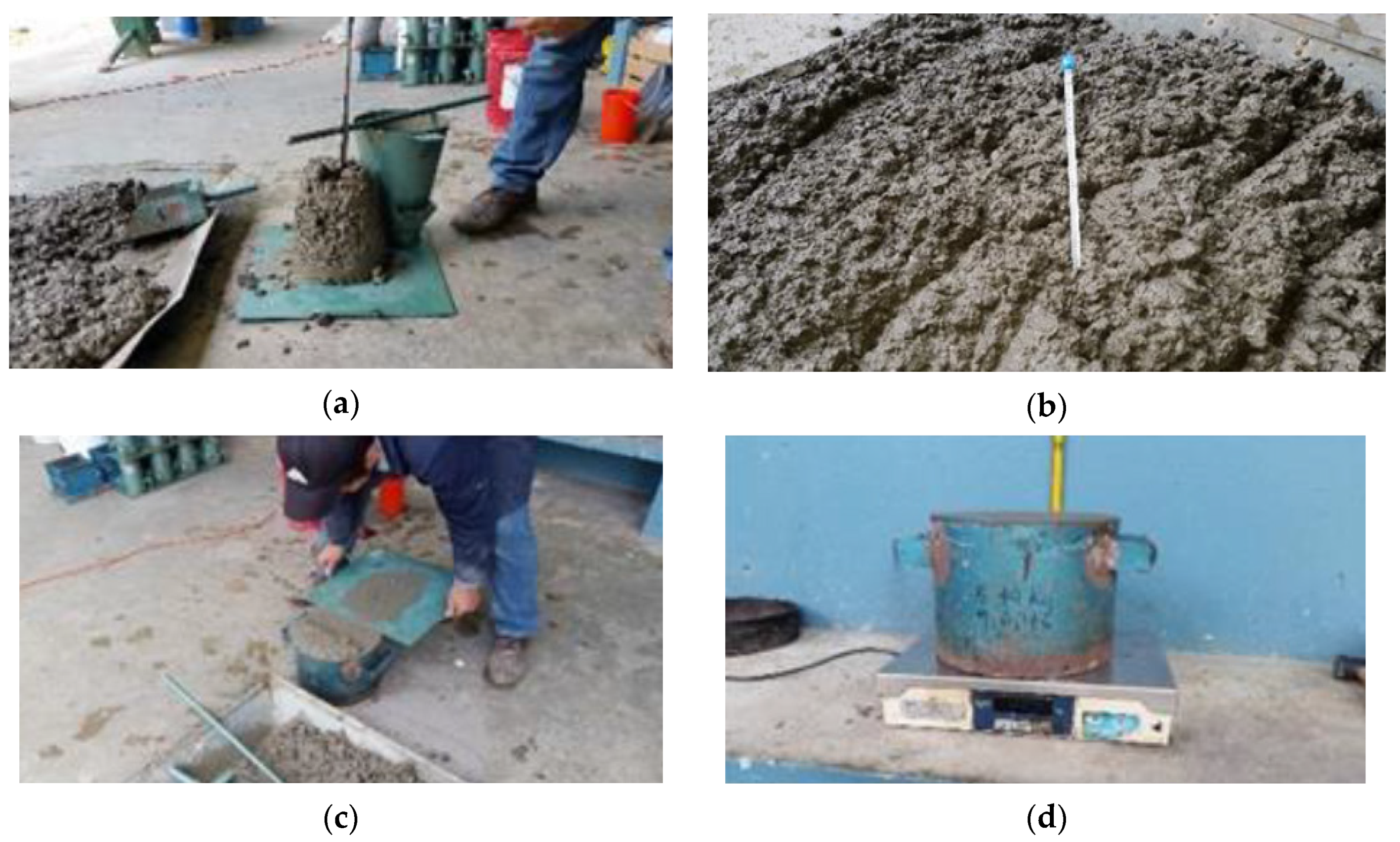

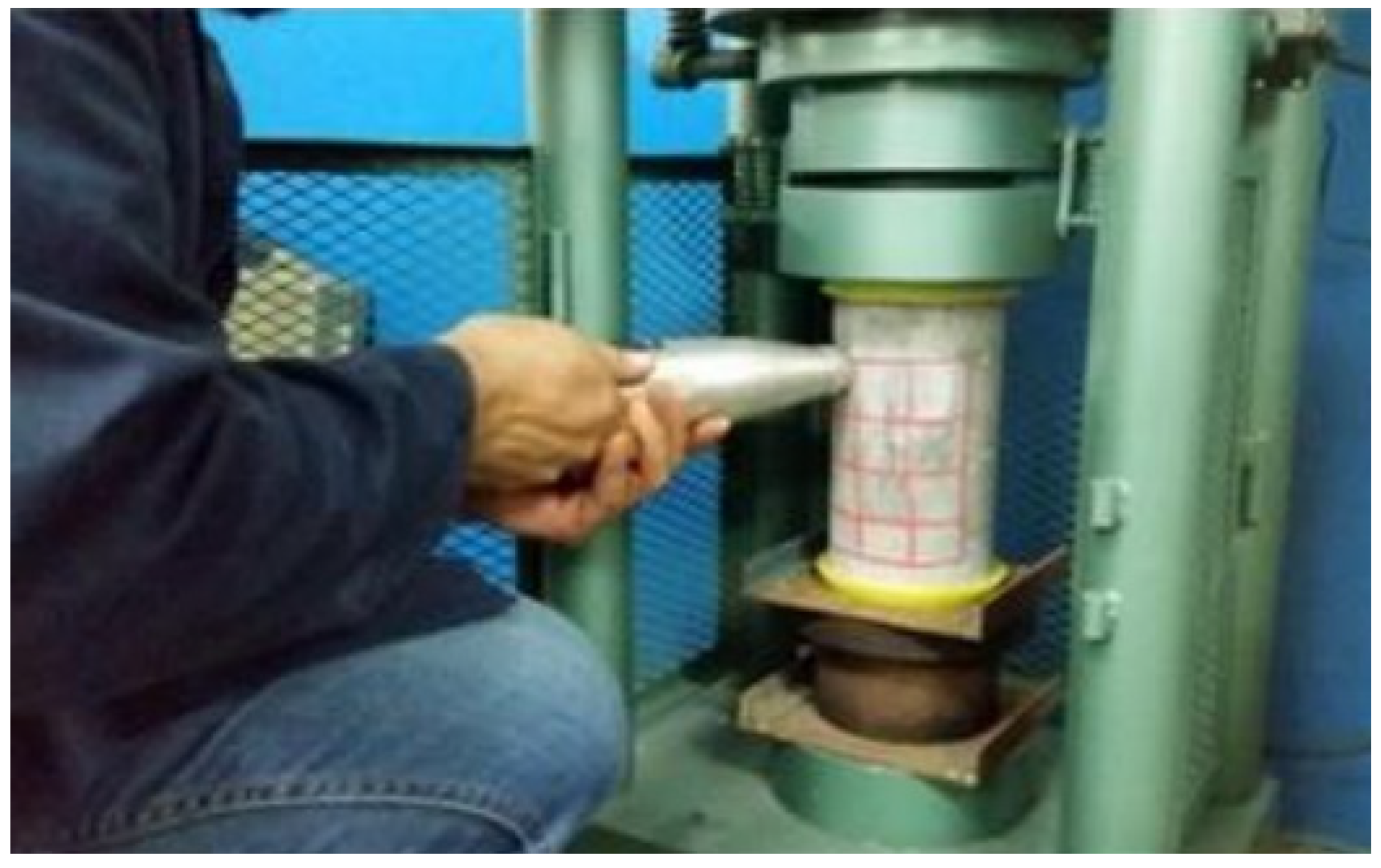

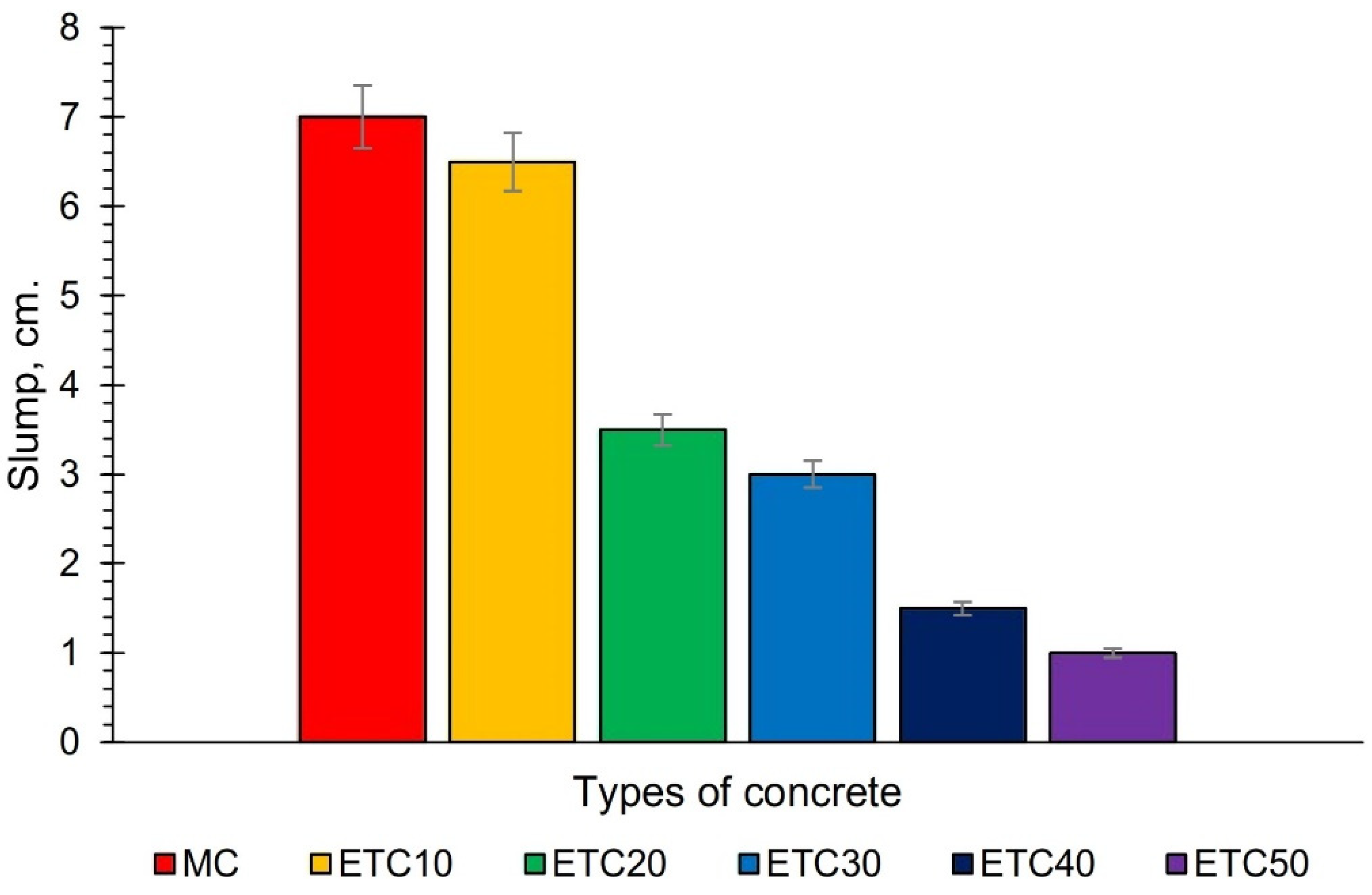
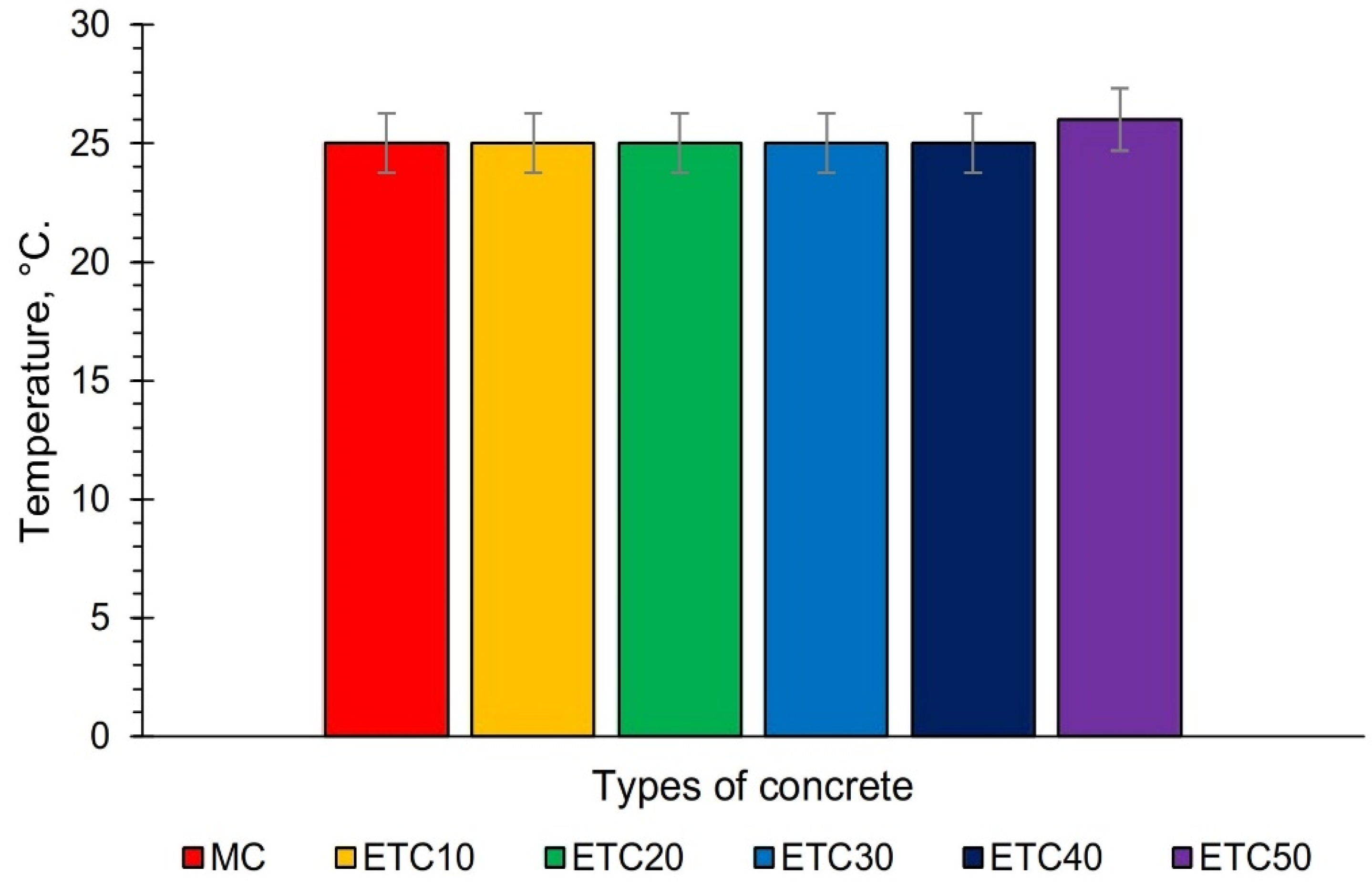
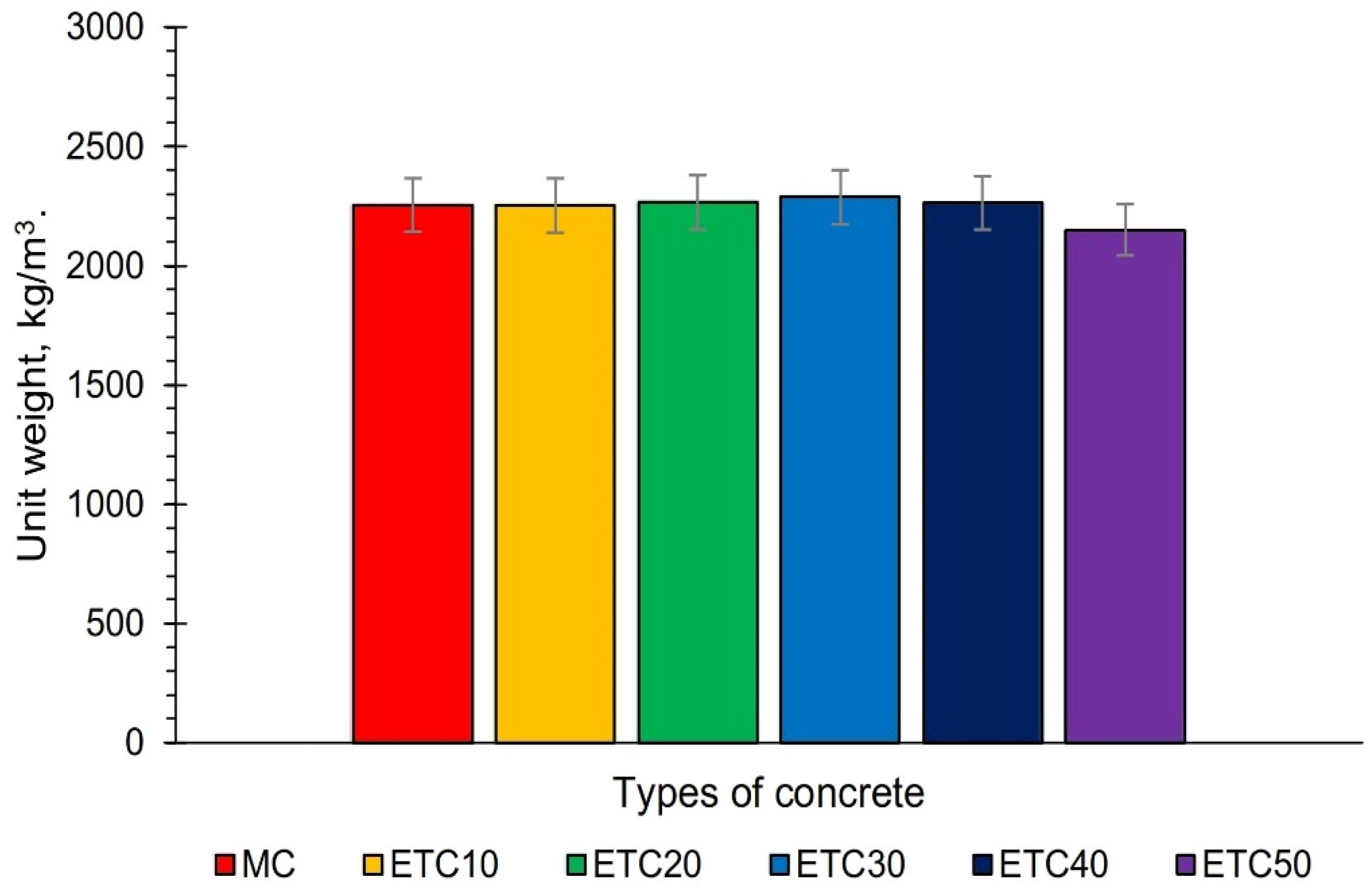
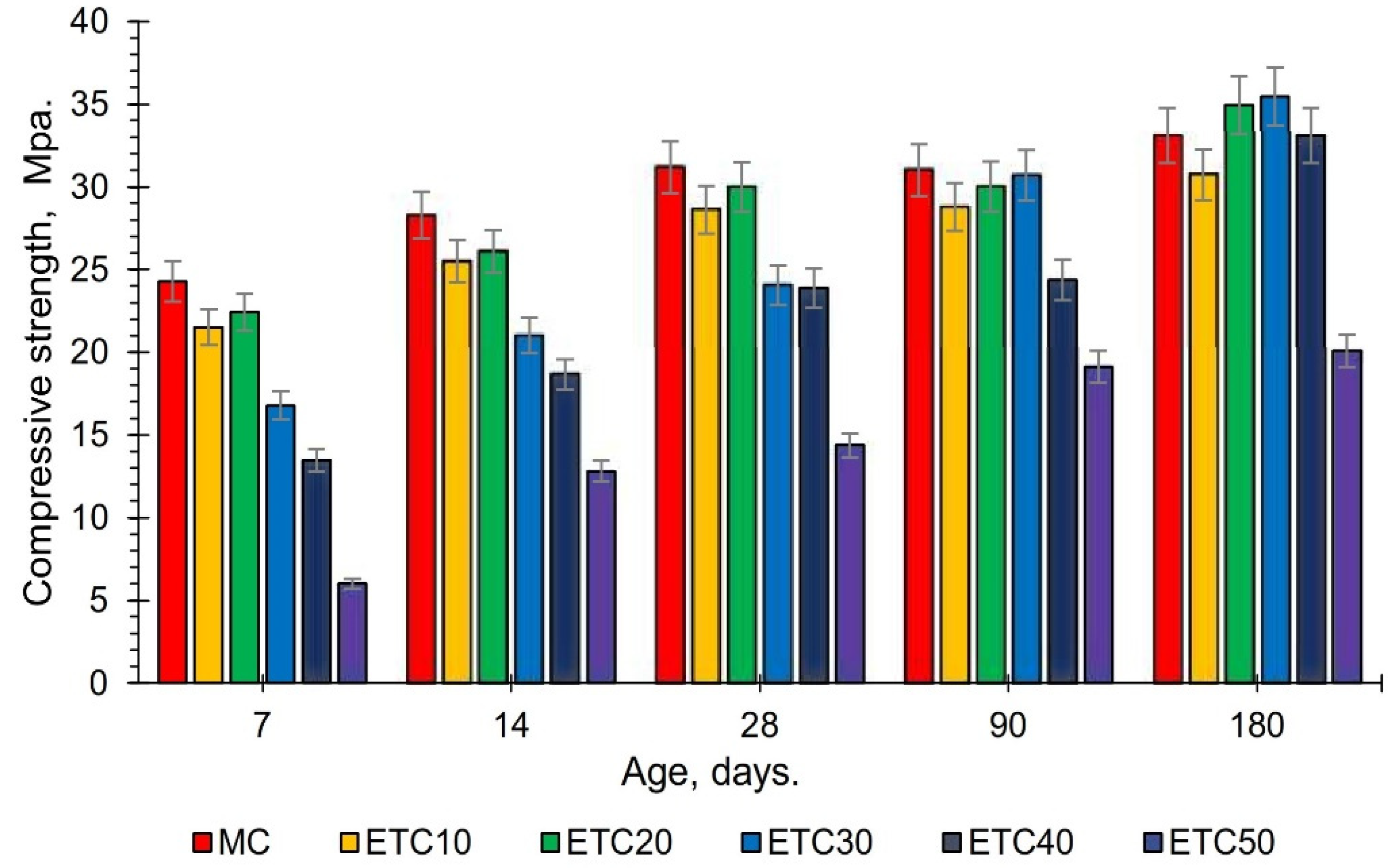
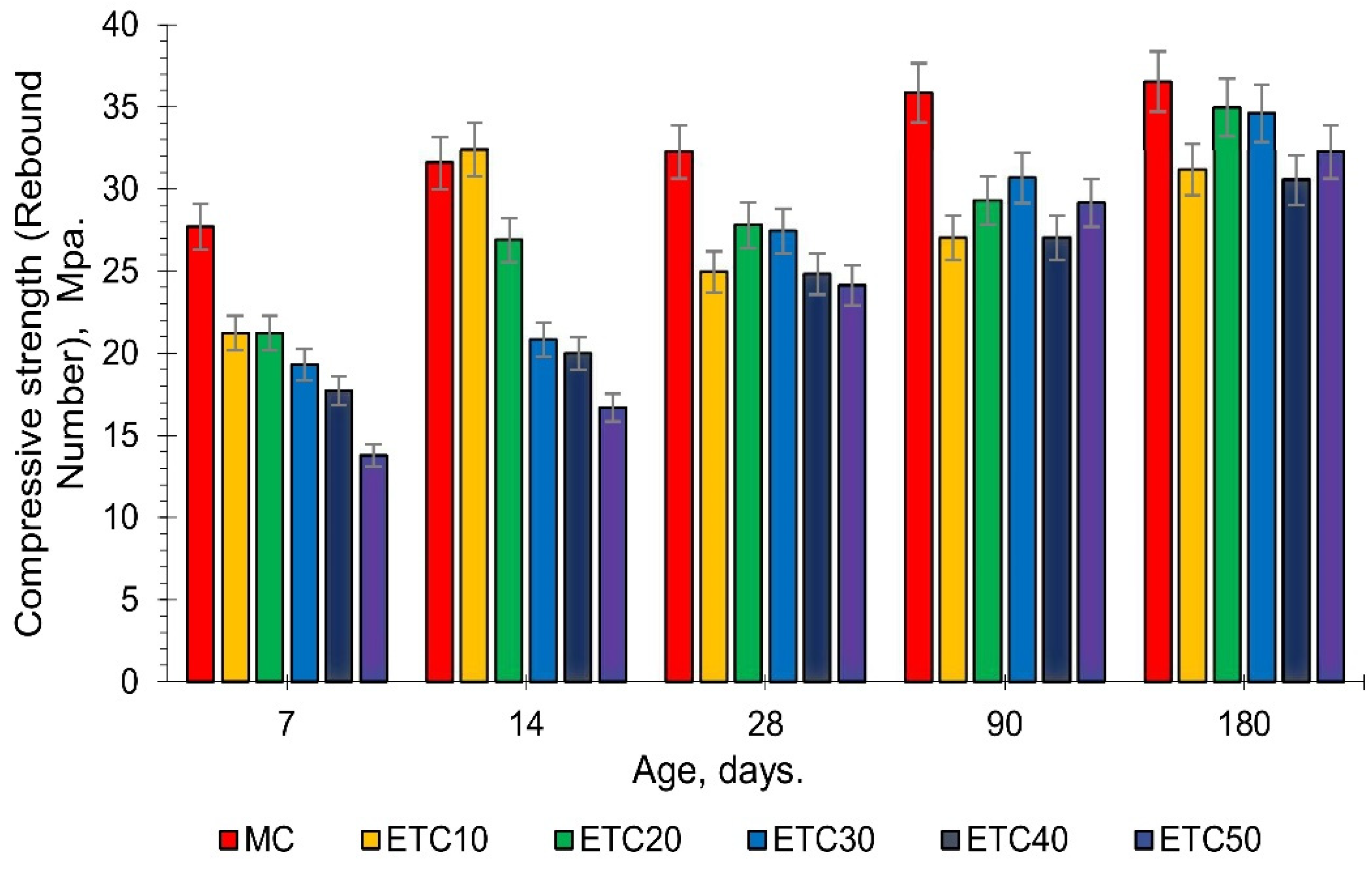
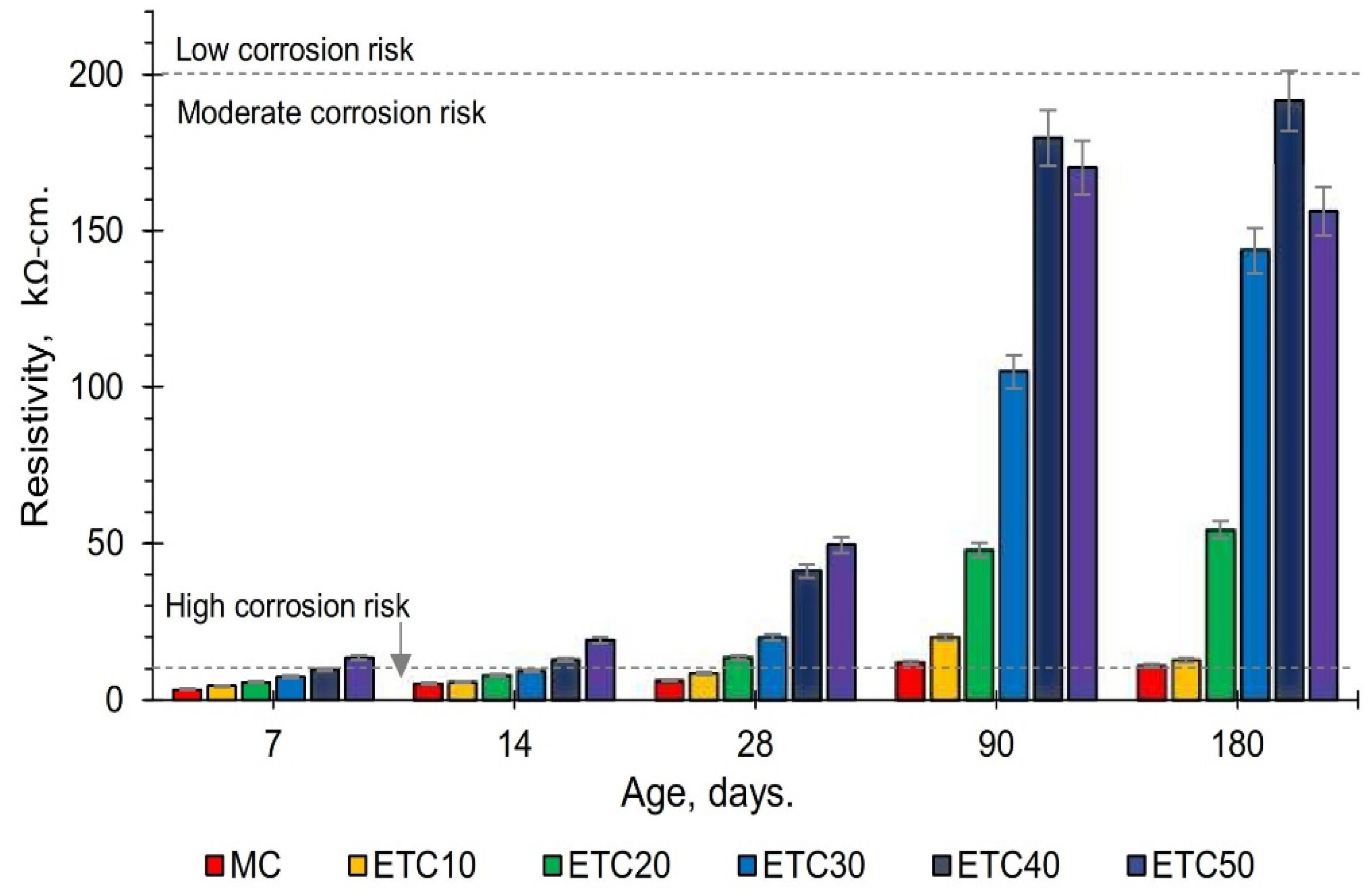
| Chemical Composition (% by Mass) | ||||||||
|---|---|---|---|---|---|---|---|---|
| Fe2O3 | Al2O3 | SiO2 | CaO | Na2O | K2O | MgO | SO3 | |
| Cement Portland | 3.872 | 5.478 | 21.187 | 63.346 | 0.564 | 0.83 | 2.068 | 2.157 |
| Sugar Cane Bagasse Ash | 5.105 | 3.150 | 77.739 | 3.995 | 0.569 | 6.672 | 0.563 | 0.406 |
| Silica Fume | 1.574 | 0.792 | 92.261 | 0.436 | 0.383 | 1.314 | 0.292 | 0.335 |
| Aggregates | Relative Density (Specific Gravity) | Bulk Density (“Unit Weight”) (kg/m3) | Absorption (%) | Fineness Modulus | Maximum Aggregate Size (mm) |
|---|---|---|---|---|---|
| Coarse (Gravel) | 2.38 | 1381 | 5.10 | - | 19 |
| Fine (Sand) | 2.60 | 1764 | 1.56 | 3.40 | - |
| Mixture | CPC 30R | SCBA | SF | Water | Aggregate Fine | Aggregate Coarse |
|---|---|---|---|---|---|---|
| MC | 315.00 | - | - | 205.00 | 746.00 | 881.00 |
| ETC-10 | 283.50 | 15.75 | 15.75 | 205.00 | 746.00 | 881.00 |
| ETC-20 | 252.00 | 31.50 | 31.50 | 205.00 | 746.00 | 881.00 |
| ETC-30 | 220.5 | 47.25 | 47.25 | 205.00 | 746.00 | 881.00 |
| ETC-40 | 189.00 | 63.00 | 63.00 | 205.00 | 746.00 | 881.00 |
| ETC-50 | 157.50 | 78.75 | 78.75 | 205.00 | 746.00 | 881.00 |
| Electrical Resistivity | Risk of Corrosion in Reinforced Concrete |
|---|---|
| ρ > 200 kΩ-cm | Low Corrosion Risk |
| 200 > ρ > 10 kΩ-cm | Moderate Corrosion Risk |
| ρ < 10 kΩ-cm | High Corrosion Risk |
Publisher’s Note: MDPI stays neutral with regard to jurisdictional claims in published maps and institutional affiliations. |
© 2021 by the authors. Licensee MDPI, Basel, Switzerland. This article is an open access article distributed under the terms and conditions of the Creative Commons Attribution (CC BY) license (https://creativecommons.org/licenses/by/4.0/).
Share and Cite
Landa-Ruiz, L.; Landa-Gómez, A.; Mendoza-Rangel, J.M.; Landa-Sánchez, A.; Ariza-Figueroa, H.; Méndez-Ramírez, C.T.; Santiago-Hurtado, G.; Moreno-Landeros, V.M.; Croche, R.; Baltazar-Zamora, M.A. Physical, Mechanical and Durability Properties of Ecofriendly Ternary Concrete Made with Sugar Cane Bagasse Ash and Silica Fume. Crystals 2021, 11, 1012. https://doi.org/10.3390/cryst11091012
Landa-Ruiz L, Landa-Gómez A, Mendoza-Rangel JM, Landa-Sánchez A, Ariza-Figueroa H, Méndez-Ramírez CT, Santiago-Hurtado G, Moreno-Landeros VM, Croche R, Baltazar-Zamora MA. Physical, Mechanical and Durability Properties of Ecofriendly Ternary Concrete Made with Sugar Cane Bagasse Ash and Silica Fume. Crystals. 2021; 11(9):1012. https://doi.org/10.3390/cryst11091012
Chicago/Turabian StyleLanda-Ruiz, Laura, Aldo Landa-Gómez, José M. Mendoza-Rangel, Abigail Landa-Sánchez, Hilda Ariza-Figueroa, Ce Tochtli Méndez-Ramírez, Griselda Santiago-Hurtado, Victor M. Moreno-Landeros, René Croche, and Miguel Angel Baltazar-Zamora. 2021. "Physical, Mechanical and Durability Properties of Ecofriendly Ternary Concrete Made with Sugar Cane Bagasse Ash and Silica Fume" Crystals 11, no. 9: 1012. https://doi.org/10.3390/cryst11091012
APA StyleLanda-Ruiz, L., Landa-Gómez, A., Mendoza-Rangel, J. M., Landa-Sánchez, A., Ariza-Figueroa, H., Méndez-Ramírez, C. T., Santiago-Hurtado, G., Moreno-Landeros, V. M., Croche, R., & Baltazar-Zamora, M. A. (2021). Physical, Mechanical and Durability Properties of Ecofriendly Ternary Concrete Made with Sugar Cane Bagasse Ash and Silica Fume. Crystals, 11(9), 1012. https://doi.org/10.3390/cryst11091012







